
![]()
Dear fellow members and friends
17 March 2008
I'm pleased to say that Sheila is recovering from her hip operation well. She hopes to be back home in a week or two. Ed had a laryngoscopy last Friday. He tells me he wasn't allowed to speak for 48 hours and can't have alcohol for 7 days. Which many of us would find a real trial! Best wishes for speedy recovery to both.
Takepart in July
Some of you know that we have been invited – along with every other organisation devoted to 'sport' very widely defined (which it has to be to include us) – to participate in the local Takepart event in the summer. After a bit of consultation with the usual suspects I offered a 'seafront taster' leisure ride based on last year's 'mysteries of Shoreham beach' on Saturday 5 July. This has been accepted by the organisers. I'm quite happy to do this one and the 'regular' ride the next day (see below) but it would be nice to have a couple of other Clarionettes (sic) to assist. How about this – if anyone has in mind a ride that's a bit more challenging, and assuming trains and other factors allow, why not schedule that for Sunday 6th? Then anyone who thought it was a bit too challenging would have the option of helping with the 'taster' the day before and would still get their fortnightly ride.
The Origins of the Clarion Cycling Club in 1894
Latest episode at the end of the Circular.
The bit I included in the last edition on women cyclists wearing 'rationals' in the 1890s seems to have stimulated some interest. If you have a look at the 'history' page on our website you'll find two new additions one of which - photos on theme of 'women cyclists' - is from our long-term supplier of historical material, Michael Walker. There is also details of a link with a new website about Clarion artwork – largely the classic Walter Crane logos and illustrations, from Donald Taylor in Lancaster.
Planning rides
Jim's doing the next one – thanks Jim. (see details below). I seem to be OK until the end of August but this may change. So anyone with a ride in mind, please don't feel you have to wait until there's another one – like 30 March – that I can't do.
Here are the remaining dates 13 (Ian), 27 April; 11, 25 May ; 8, 22 June; 6, 20 July, 3, 17, 31 Aug; 14, 28 Sept, 12 Oct, 2, 16, 30 Nov, 14 Dec.
If you want to lead a ride on one of these dates: -
- Work out your route and – very important - check the trains on the possible dates making sure to research train availability – one needs to check the 'details' on the Journey Planner website to make sure it's a 'train' and not a 'replacement bus'.)
- Contact me suggesting the proposed date for your ride (I'll then put your name beside the date so everyone can see what's still up for grabs)
- If you've booked a date some way ahead please confirm to me that the ride is still on at least 3 weeks before
- Just before the previous ride to the one you're planning – or earlier if possible - send me the details laid out in the familiar format so I can put it straight into the next circular.
Boots!
Ian
The Next Ride
Sunday 30 March
Clarion Summertime Special
British Summer Time starts on 30 March when the clocks go forward one hour. To give you extra time to remember to adjust your timepieces, both internal and external, we will leave the railways to the engineers and go for a nice, short, lazy, slow ride along the Undercliff Walk to Saltdean, have lunch at the White Cliffs Café, and come back. Just that.
Meet at 12.00 BST (11.00 GMT) at the Palace Pier. The journey from the Pier to Saltdean is 5 miles, and takes about an hour (at my pace, that is!).
Points of interest: We may see more of the washed-up wood, which the enterprising folk of Ovingdean and Rottingdean have used to create some simple beach structures. We might even have time to play with some of it.
See you in the summertime!
Jim
P.S. Just in case you wake up at 11.55 (BST), ring me on 07742-963239. We might wait for you.
The Last Ride - Jim's Report
16 March 2008
Three Bridges – Ifield – Rusper – Charlwood – Crawley – Three Bridges
Fred, Jeff, Jim, Joyce and Roger met at Brighton Station and took advantage of the 'Groupsave' discount to get returns to Three Bridges for £4.65 each. (I used my magic plastic ticket). Jeff had had his saddle vandalised, and Joyce took this as further evidence that everyone has gone mad and We Are All Doomed. In fact, the dolphins may have already left the planet!
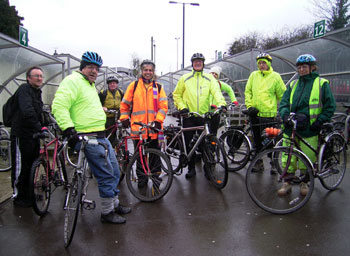
The start at Three Bridges station (with superior cycle parking facilities)
We met Amanda, Ian, Leon and Nick at Three Bridges. This was the first ride Leon had organised for us, and Roger thought it might have suffered from 'First Ride Syndrome' (a.k.a. continuous rain) like his own debut last year. It certainly did rain all day. But did it dampen our spirits? Yes! I mean, No! (But it did dampen my map, my wallet, and my ride notes, so this could be a rather short report!)
Considering that much of the ride was through the suburbs of Crawley, Leon had found us some surprisingly 'green and pleasant' little paths, the first of which we shared with a robin, a blackbird and a squirrel. This took us through Furnace Green to Tilgate Park, which used to extend nearly all the way to Three Bridges Station. In the park, we saw Tilgate Lake, also known as Campbell's Lake, after the late Donald Campbell who used to keep his world-water-speed-breaking boat Bluebird here. Jeff also has a Crawley connection, and was able to supplement Leon's commentaries very effectively; he told us about the manor house that used to stand here, and the place nearby where his mother is buried.
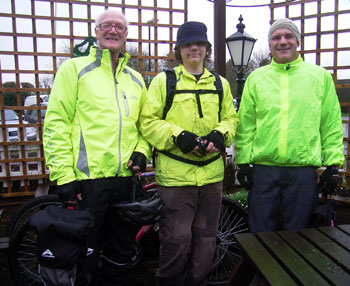
Leon, his grandson Luke and son Laurence
After crossing the A23, and being joined by Leon's son Laurence and grandson Luke, we had a look at Broadfield House, a Grade II Listed Building dating back to 1830 which is sadly neglected and only partly occupied. (It apparently used to house Radio Mercury). It looks out over a lake with ducks etc. Very nice. I'll leave it to Ian to supply the relevant architectural jargon, or you can look it up in Pevsner.
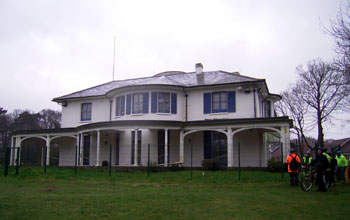
Broadfield House
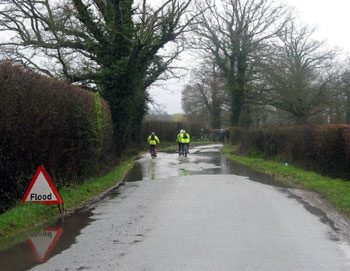
Flood! - Jim's photo
On towards Ifield, alongside the Broadfield Brook, a tributary of the Mole, which was very swollen after (and indeed during) the rain; the ducks didn't seem to know quite where to go. There was also an interesting Garden Centre where you could also buy kittens and carpets, but we passed it by.

St Margaret's church at Ifield
We stopped to look at St Margaret's 13th century church at Ifield, while Laurence and Luke minded the bikes (they'd seen it before). Unlike all the empty churches I'd visited before on Clarion rides, it was a hive of activity and we only just squeezed in. I felt slightly awkward, as though we were intruding. I noticed that most of us were removing our cycle helmets before entering, out of some sense that this was the right thing to do, although Amanda said that ladies were supposed to keep their heads covered. I was reminded of the line from Philip Larkin's poem 'Churchgoing':
"… Hatless, I take off
My cycle clips in awkward reverence"
(they didn't have cycle helmets in the 1950s!) When I got home and read the guide booklet I had bought in the church, I was amazed to find a quote from that same poem included. Larkin, like myself and, I would imagine, most Clarionettes, was an atheist, but, like us, was interested in the architecture, and clearly experienced the same 'awkwardness' in entering a church.
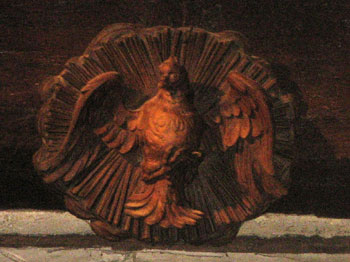
The angry dove - Jim's photo
The service had only just finished, and lots of people were milling around, and a couple of singers were practising a choral piece. We were welcomed, and shown round by a gentleman who was clearly very proud of his church. He showed us the woodcarving of a dove which had been in the original church, and pointed out that close examination reveals it to be 'not exactly a peaceful dove'.
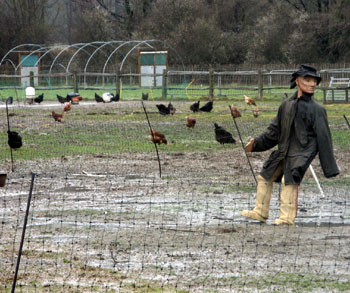
Scarecrow - Jim's photo
After Ifield we made for Rusper, and on the way we passed a farm with some very healthy-looking free-range hens looked after by a very lifelike scarecrow – a good place to get eggs – but the scarecrow would not budge when I asked him for some. The Star Inn at Rusper was a very welcome oasis for nine soggy Clarionettes and two soggy temporary Clarionettes, even though the log fire was not lit. We had some lovely food, washed down in my case by a very nice pint of Spitfire; when Amanda and Nick had finished their sandwiches, a truly enormous plate of Cheesy Chips arrived for them, which, even among the eleven of us, we failed to finish. The conversation was of future rides, including the Naked Bike Ride (of course), and Ian's piece in the latest Boots & Spurs magazine; and we all got our Clarion membership cards.
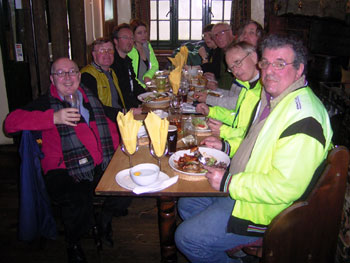
Lunch at the Star Inn
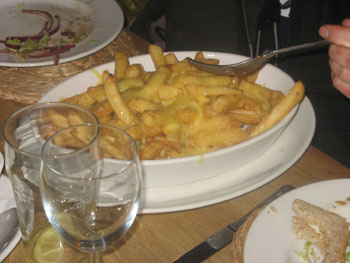
Small portion of cheesy chips! - Jim's photo
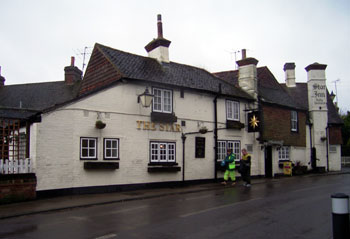
The Star Inn
Laurence and Luke left us in the pub, making for Colgate and a promise of a future ride. From Rusper, we whizzed down Russ Hill to Charlwood, passing on the way the Lowfield Heath windmill, which had been moved from its original location when Gatwick Airport was built; it was minus its sails, or "sweeps" as they are apparently known in Sussex. (We were in fact almost in Surrey at this point, and would have been before they moved the border some years ago).

Lowfield Heath windmill - Jim's photo
Charlwood is apparently under threat from the proposed second runway at Gatwick. I know which I'd prefer! Even with only one runway, the airport was making a dreadful noise as planes were constantly revving up for takeoff, and those coming in to land would roar across our heads every few minutes. I think that if anything sums up the ugliness of modern life it was that abominable roaring, booming noise in the midst of otherwise beautiful countryside, although of course the emissions are far more deadly.

The first Friends Meeting House to be built in Britain
Our return route then ran alongside the outward one for a while before diverging again. We stopped to look at the first Friends Meeting House to be built in Britain, and wondered 'why here?' Convenient for the airport? Back across the A23, and hurrying past the macabre home of acid-bath murderer John George Haigh, we reached Crawley, which does actually have an old town centre amongst all the shopping malls and precincts; the main landmark is the 'gallows' structure outside the George Hotel, although I was not clear as to whether it was ever actually used as a gallows. Finally returning to Three Bridges station and bidding farewell to Ian and Amanda, we were pleased to note that lifts are being installed there, which will save us lugging our bikes up the steps in future.
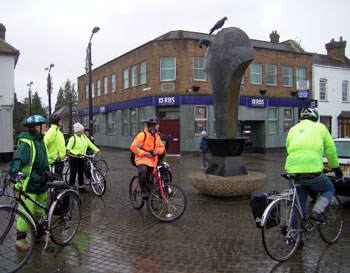
Public art in Crawley
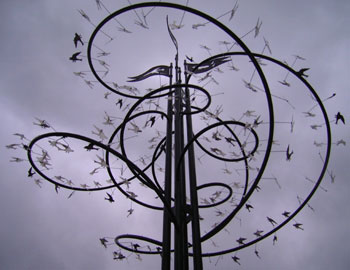
Flock of martlets - more public art in Crawley
Sorry this has been so long, but there were so many treasures to tell you about, thanks to Leon, who put an enormous amount of preparation into this ride, as evidenced by the papers he gave me to help with the write-up. I hope I have done it justice.
Jim
The Origins of the Clarion Cycling Club in 1894
Though all the feedback I've had has been positive, there hasn't been very much of it – and I'd like to hear your opinion as to whether it's worthwhile me ploughing on with this enterprise. But there has, as I said earlier, been a bit of interest in 'rationals' and related matters. So here's another snippet on that before we turn to the Cycling Club itself. Last time I mentioned how at the end of July 1894 the Clarion had acquired a 'cycling correspondent' with a regular column – one Swiftsure – and I quoted a little piece about 'rationals' from his very first effort.
On the 18 August – amid reports of the emerging sport of cycle racing and so on he writes: -
'My correspondent also says that they have 'women cyclists' who
wear 'rationals' in Bradford (have they? Then I'm coming to Bradford
to see them) but no Clarion Cycle Club. This should be remedied
without delay.'
Quite so, so back to the CCC story.
The Clarion Postbag at this time was a sort of combined letters page and editorial put together by Blatchford himself on the basis of some of the correspondence received from readers. There had been fears among readers that the paper would be forced to close down. The week before, responding to a comment from Leonard Hall in the previous week's edition, which we will return to later, Blatchford had explained that the paper was just about getting by financially, though not able to pay its staff as much as it should. I think that the letter and Blatchford's response tells us a great deal about the relationship that had developed between the paper and at least some of its readers in the early days of the Clarion. On 9 June 1894 this appeared.
The following letter, which comes from the Birmingham Branch of the "Clarion" Cycling Club, may be taken as earnest of the many others sent in by our readers. It is worth noting that this letter, and another equally kind and thoughtful, from the Soho Co-operative Society, reached us before the statement of last week was in print.
Dear Nunquam and Comrades of the Clarion
We, the members of the Clarion Cycling Club have been pumping Leonard Hall during his visit to us as to the circulation of the Clarion, and are heartily sorry to hear that it is not what it should be, nor what we imagined. The news came as a great surprise, as many of us were under the impression that the Clarion was in a flourishing condition; and this, we believe is what is thought by hundreds of other Clarion readers.We think that it is only fair to us all to make known the real state of affairs, so that each may put his shoulder to the wheel and take his share of making the Clarion safe.
The Clarion is not yours alone, but ours; and we should be allowed to have a hand in saving it. Its going down means personally an interest in life gone; socially as serious blow to our movement. And on these grounds and especially the latter, we ask, as comrades, to be allowed to take our part in its continuance.
Socialists are not very numerous in Birmingham, but 95 percent of them are Nunquamites, and with a few exceptions, all are Clarionettes. The majority of these, we feel certain, will gladly do their best when they learn the true state of affairs. And what is true of Birmingham is no doubt true of other places.
At any rate, give us a chance, and let us show we are comrades in the true sense of the word; for although none of the undersigned have ever met the Clarion staff personally, our sense of comradeship towards you is a vivid as though we meet each day. You will find hundreds of others the same. Put us on our mettle. The Clarion is too good to lose.
I omit the twelve signatures for prudential reasons.
---
Now, in answer to that manly and generous letter, and many others like it, I have to say that the Clarion is in no danger. Its position is quite safe and its future sound.
But it does not pay the staff a living wage.
As to offers of help, we cannot, of course, accept them. Our friends can do us no good nor do we mean to let them try. We offer our paper for a penny, on the basis of it being worth the money.
We do not ask, nor desire, anyone to buy the Clarion for the sake of the cause, nor for the sake of the staff, nor for anything else. We say, "If you do not think our paper is worth a penny to you do not buy it!' But we think that if you read it you ought to pay for it.
That is our position. We have put it plainly before the readers. We say that if all regular readers of the Clarion paid for the paper we should have double or treble our present circulation, and then we should get a fair wage and our readers get a better paper.
---
This last bit will seem a bit puzzling. What had alarmed the B'ham Clarion CC started a couple of weeks before [26 May] when Leonard Hall, reporting on Manchester and District, in the paper's 'Notes from the Front' wrote 'I am unpleasantly surprised to find that a number of I.L.P. clubs which owe their existence to Clarion propaganda are – by providing a club copy of this paper - having the incidental (and I am sure unconscious) effect of interfering with the same, as quite a number of ILPers appear to have contracted the simple habit of confining themselves to the use of the communal copy when they used to buy their own.' Blatchford himself was a lot less charitable. He concluded the piece I've quoted above 'I don't honestly think the Labour party are worth the trouble. Men who will try to read their own Labour papers without paying the writer his wages, do not promise to make very good socialists.'
Meaning of course the I L P – the Labour Party wasn't formed (as the Labour Representation Committee until 1900 and officially took on the name Labour Party in 1906.
Ian